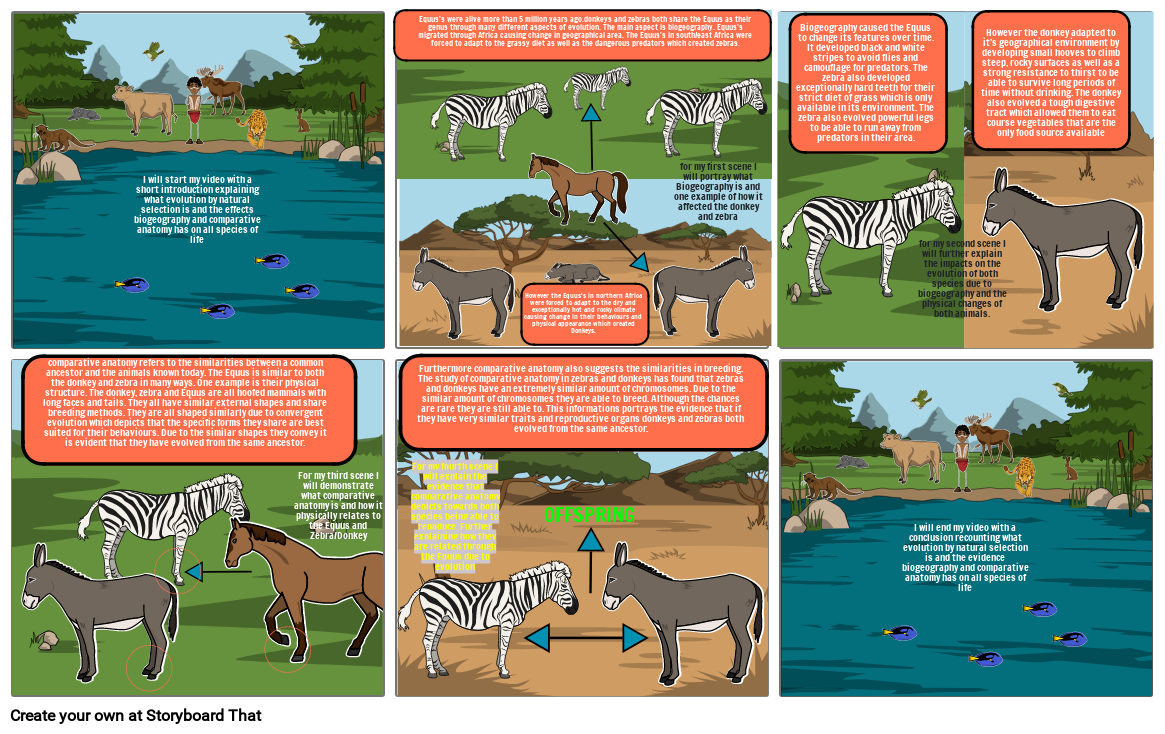Unknown Story

Storyboard Text
- I will start my video with a short introduction explaining what evolution by natural selection is and the effects biogeography and comparative anatomy has on all species of life
- Equus's were alive more than 5 million years ago.donkeys and zebras both share the Equus as their genus through many different aspects of evolution. The main aspect is biogeography. Equus's migrated through Africa causing change in geographical area. The Equus's in south/east Africa were forced to adapt to the grassy diet as well as the dangerous predators which created zebras.
- However the Equus's in northern Africa were forced to adapt to the dry and exceptionally hot and rocky climate causing change in their behaviours and physical appearance which created Donkeys.
- for my first scene I will portray what Biogeography is and one example of how it affected the donkey and zebra
- Biogeography caused the Equus to change its features over time. It developed black and white stripes to avoid flies and camouflage for predators. The zebra also developed exceptionally hard teeth for their strict diet of grass which is only available in its environment. The zebra also evolved powerful legs to be able to run away from predators in their area.
- for my second scene I will further explain the impacts on the evolution of both species due to biogeography and the physical changes of both animals.
- However the donkey adapted to it's geographical environment by developing small hooves to climb steep, rocky surfaces as well as a strong resistance to thirst to be able to survive long periods of time without drinking. The donkey also evolved a tough digestive tract which allowed them to eat course vegetables that are the only food source available
- comparative anatomy refers to the similarities between a common ancestor and the animals known today. The Equus is similar to both the donkey and zebra in many ways. One example is their physical structure. The donkey, zebra and Equus are all hoofed mammals with long faces and tails. They all have similar external shapes and share breeding methods. They are all shaped similarly due to convergent evolution which depicts that the specific forms they share are best suited for their behaviours. Due to the similar shapes they convey it is evident that they have evolved from the same ancestor.
- For my third scene I will demonstrate what comparative anatomy is and how it physically relates to the Equus and Zebra/Donkey
- For my fourth scene I will explain the evidence that comparative anatomy depicts towards both species being able to repoduce. Further explaining how they are related through the Equus due to evolution
- Furthermore comparative anatomy also suggests the similarities in breeding. The study of comparative anatomy in zebras and donkeys has found that zebras and donkeys have an extremely similar amount of chromosomes. Due to the similar amount of chromosomes they are able to breed. Although the chances are rare they are still able to. This informations portrays the evidence that if they have very similar traits and reproductive organs donkeys and zebras both evolved from the same ancestor.
- OFFSPRING
- I will end my video with a conclusion recounting what evolution by natural selection is and the evidence biogeography and comparative anatomy has on all species of life
Over 30 Million Storyboards Created

